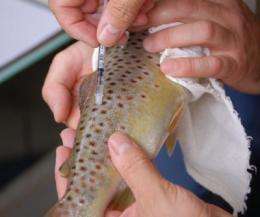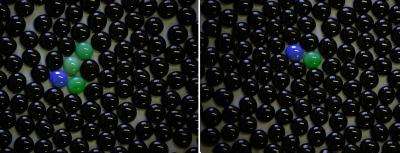Explosives and fish are traced with chemical tags

Researchers at the University of Oviedo (Spain) have come up with a way of tagging gunpowder which allows its illegal use to be detected even after it has been detonated. Based on the addition of isotopes, the technique can also be used to track and differentiate between wild fish and those from a fish farm, such as trout and salmon.
A new method for tagging and identifying objects, substances and living beings has just been presented in this month's issue of the Analytical Chemistry journal. Its creators are scientists at the University of Oviedo who have patented the procedure for inserting chemical tags into products in a way that allows them to be unmistakably identified over time.
The technique consists of adding two stable (non-radioactive) isotopes (types of the same chemical element but with a different number of neutrons) at an established ratio to the object that is to be followed. Then, with an instrument called a mass spectrometer, a sample can be verified as having the predefined isotope ratio. If it does, it is therefore the tagged product.
"This technology is applicable to the invisible tagging of manufactured substances and objects such as explosives, jewellery, artwork, foods and medicines, which helps to prevent fraud and counterfeiting," explains to SINC José Ignacio García Alonso, one of its authors. "Through simple analytical techniques, a product can be traced from its origin and any possible illegal uses can be detected," he adds.

The researchers have applied this method to gunpowder, an example of an explosive, by adding two tin isotopes (Sn117 and Sn119). After preparing three different mixes (each with differing isotopic proportions so that they can be distinguished from one another), the results reveal that even after detonation the added tags can still be detected in the explosion remains.
García Alonso states that "such a procedure can be used in tagging explosives for civil or military use and can even go as far as identifying the product used in a terrorist attack."
Safe for health and the environment
The researcher also highlights that the technique can be used in living organisms without risk to health or the environment: "All living beings have these isotopes, the only thing we have done is change their ratio." Monitoring of seed dispersal or fish populations are fields of scientific research that could benefit from this technology.
In fact, the team has successfully employed barium isotopes (Ba135 and Ba137) for tagging trout. What is more is that the injected tag in the female is transgenerational, meaning that it passes to her eggs and therefore the first generation of fry. The isotopic information is stored for life in the otoliths – a calcareous structure in the inner ears of the fish from where samples are taken.
García Alonso points out that "different tags can be injected into the trout so that the procedure can be made more specific for the descendents of a single individual or group."
The method is currently being used to assess the effectiveness of salmon repopulation in rivers in Asturias, Spain. The scientists inject one type of chemical tag into wild salmon and another type into those from a fish farm. When the fry raised in captivity are returned to the river, the efficiency of the repopulation process can be determined and river populations can be indirectly estimated.
More information: Analytical Chemistry 84 (1): 121-126 y 127-133, January 2012. Doi: 10.1021/ac201945g y 10.1021/ac201946k
Journal information: Analytical Chemistry
Provided by FECYT - Spanish Foundation for Science and Technology
















